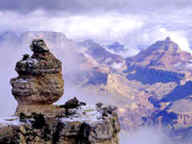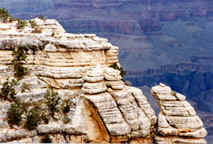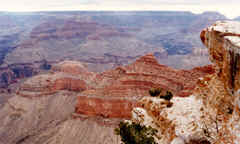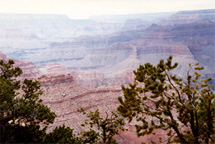Dec 12, 2025
Dec 12, 2025
Oh! Grand Canyon
 When one looks at the Grand Canyon from any one of the several view points on its rims, one's breath is taken away, one's mouth opens as if dumb founded, one is flabbergasted at the staggering size and amazement of colors. And one is left wondering as to how such a symphony of structures of stupendous stature was sculpted on earth and by what earthly and unearthly forces! What a magnificent scene! What grandeur! Perhaps nowhere on earth has nature nurtured so striking an example of the power of something as humble as water. But Grand Canyon is even more than all this!
When one looks at the Grand Canyon from any one of the several view points on its rims, one's breath is taken away, one's mouth opens as if dumb founded, one is flabbergasted at the staggering size and amazement of colors. And one is left wondering as to how such a symphony of structures of stupendous stature was sculpted on earth and by what earthly and unearthly forces! What a magnificent scene! What grandeur! Perhaps nowhere on earth has nature nurtured so striking an example of the power of something as humble as water. But Grand Canyon is even more than all this!
 The Grand Canyon is one of the seven natural wonders of the world. It is in the grand company of the grandest natural wonders viz. the Himalayas, Victoria Falls, the Great Barrier Reef etc. The Grand Canyon is not the deepest canyon in the world and yet it is the most visited of them all. Located in the desert of Arizona State far away from everywhere, except the world famous casino town Las Vegas, which is about 400 kms west, and it draws five million tourists every year. Las Vegas, on the other hand, attracts 30 million people annually, a good half of them come to make a quick buck (perhaps better half are able to resist the temptation), a kind of gold rush for which a tradition exists in this area.
The Grand Canyon is one of the seven natural wonders of the world. It is in the grand company of the grandest natural wonders viz. the Himalayas, Victoria Falls, the Great Barrier Reef etc. The Grand Canyon is not the deepest canyon in the world and yet it is the most visited of them all. Located in the desert of Arizona State far away from everywhere, except the world famous casino town Las Vegas, which is about 400 kms west, and it draws five million tourists every year. Las Vegas, on the other hand, attracts 30 million people annually, a good half of them come to make a quick buck (perhaps better half are able to resist the temptation), a kind of gold rush for which a tradition exists in this area.
Its 'Grand' name does not do justice to its grandeur. It is a valley sculpted by the Colorado River using a chisel made of nothing harder than water to cut and expose layers after layers of history. The 6000 feet deep Grand Canyon is also two billion years deep.
Central North America Was Situated on Equator
The cutting edge of water has created a show window: a large one, - 450 kms long, 1500 meters deep and 15 kms wide. Rain and wind, alas, have eroded the last 250 million years of layers of rocks. We traverse these vast eras in the space of only one and a half km, from the rim to the river, going back to the time when only micro life such as bacteria and algae existed on earth. And the seeker can see fossil records.
It may be unbelievable that about 250 million years ago (mya) this part of America was on the equator and therefore richer in life. Then about 200 mya North America started to separate from the mother landmass Pangaea and gradually move to its present location (India stared separating from Africa around 150 mya). The Grand Canyon's layers indicate that at least seven seas, several lagoons and a desert have existed there, off and on thereby forming various layers of different rocks. Kaibab, the present top layer was formed 250 mya but has become the top layer only because erosion has removed the 8000 feet thick layers that formed afterwards. The bottom most layer, viz. Vishnu schist, of the Grand Canyon was formed 2,000 mya. Thus these layers contain fossils of life forms that existed during the period between 2,000 mya and 250 mya, covering almost half of the age of earth.
Poignant Human History
No wonder this fabulous and fantastic formation captures the imagination not only of those who witness it but also of those who hear or read about it. The eye is literally hit by the rich colours of the precipitous faces of rocks - white, yellow, green, red and black, in all their blends and spectral hues. In addition to the scenic splendour and geologic mystery, the natural history of the Grand Canyon is extraordinary in its diversity. But the human history, connected with this natural wonder, projects a poignant dimension of exploitation, killing, and drama, the most important being the daredevil adventures defying death. Therefore in this trip to U.S.A., after the birth of my Grand Son, the Grand Canyon of Colorado was top priority.
By Road to Grand Canyon
This time I was living with my son Sandeep and daughter-in-law Anuradha at Los Gatos, an exquisite suburb of San Jose, one-hour drive from San Francisco. Distance to Grand Canyon is 1200 kms, but we took a detour of additional 600 kms. My friend Mohan, a Ph.D. in engineering, and 65 years of age who had come to meet me from Minnesota and Param Singh, a friend of Sandeep, also joined us in this fantastic journey. We could start only on first December and were required to be back before sixth Dec. We started by 7:45. We had decided to drive 1200 kms straight and reach St. George, a town on the border of Zion National Park by about 9 in the evening. I took out some books on Grand Canyon and started reading with spicy interference in between by everybody.
The native Americans must have entered from northeast Asia into Alaska in North America around 20000 BC when the Bering Strait was frozen. Evidence of their presence by 12,000 BC is found in Monte Verde, Chile, south of South America . And, as per evidence obtained, the natives had entered the Canyon only around 2000 BC. The interesting evidence consists of small figurines of animals crafted from twigs of willow or cottonwood. The split-twig figurines are 3 to 30 cms in height. Other evidence shows that these people were hunter-gatherers similar to the Archaic Group of Desert Culture of the area. The figurines are crafted with admirable economy, beauty and inventiveness in the use of available material. As some figurines have a twig piercing them, it appears that they had a ritualistic and magical purpose. This work can be compared to the crafts of the Indo-Harappan civilization of about 6000 BC which became a highly advanced urban, agricultural and industrial civilization by about 3500 BC.
Then from 500 AD to 1200 AD, evidence is found of people living there who are known as the Anasazi ('our ancient people'). They were mainly hunter-gatherers who 800AD onwards supplemented their food with crops like squash (a kind of pumpkin) corn and beans. They were tough as they were living in these harsh climates almost naked. (Evidence, in a cave in Missouri, of shoes of Native Americans, made of ropes of yucca fibers dating as far back as 6000 BC and 1000 AD, has been found. It is amazing to see little advancement in the technology in the era straddling7000 years.). Around 1200 AD Anasazi abandoned the Grand Canyon probably because of severe changes in the climate. (Around the same period, some hundred kms northeast of the Grand Canyon, in the desert area of Colorado State, evidence of Cannibalism among Anasazi has been found, another indication of severe and sudden non -availability of food. This is despite the belief among the Natives that ' all things in nature have a soul, and that mankind must live in harmony with nature'. About 50 miles east of the Grand Canyon around Oraibi (at least since 1200 AD, the longest continuously inhabited village in North America) Hopi (the bear clan people) are living and they claim that Anasazi were their ancestors.
Silver, Greed and Arizona
The prospect of gold lured the first white men to this region. The conquistador Francisco Vasquez de Coronado, in 1540, explored and instead of gold, found it inhabited by hostile people living in mud houses (Pueblo). He then sent a party led by Garcia Lopez de Cardenas who came up to the eastern boundary of the Grand Canyon. The desert-like mountainous Grand Canyon didn't impress the gold prospector, the first European to see the Grand Canyon. In 1736, during Spanish era, a fantastic silver strike attracted thousands to a place known as Arizonac. It was said that one could find lumps of silver, which was not found, but the area got the name Arizona.
It was in 1776 another Franciscan missionary Francisco Tomas Garces came upon "a deep passage'. Through it coursed a tawny stream"; he called it Rio Colorado-Red River. The river may not be red today because all the red silt and mud from its drainage gets trapped in the lake Powell created by Glen Canyon Dam. In 1821, Mexicans won their independence from Spain. In 1848 the US attacked and won Arizona. In 1857 an Army expedition led by Lt. Joseph Ives was launched to explore how far the river Colorado was navigable. From the mouth of the river in Gulf of California they came up to the Black Canyon, near the present site of Hoover Dam, 25 kms southeast of Las Vegas. Lt. Ives wisely declared this point as the head of navigation. He, however, continued overland into the heart of the Grand Canyon region. In his report he declared the area as "altogether valueless" and, " Ours has been the first, and will doubtless be the last, party of whites to visit this profitless locality. '(Grand Canyon would remain) forever unvisited and undisturbed."
Golden Touch To "Altogether Valueless"
Grand Canyon had to wait for a highly adventurous person with knowledge of geology, paleontology, and ethnology, and aesthetic sensibilities, and who could express his experiences in equally powerful language before Grand Canyon could claim its true place among the natural wonders of the world. And such a person came in 1869, a Civil War veteran by the name of John Wesley Powell who had lost his right hand in that war. This dare devil of a man achieved the formidable feat merely with four tiny wooden boats and a team of ten inexperienced men. His boats were often broken in the rapids; one man of the team returned even before entering the Grand Canyon having had enough of scary adventure; three men left him after passing through some of the dangerous rapids, at what is now known as Separation Point. Soon after that Powell crossed the fateful rapid successfully, but the three men? How often most of us loose courage and patience when we are fairly close to success! Powell converted the 'profitless, altogether valueless and useless area' in to one of the most profitable and valuable areas in the world.
We had reached St. George at about 8 PM. St. George is a hilly town on the border of the mysterious formations. On 2 Dec. we enjoyed the excitement of amazing Zion National Park in the earlier half and even more amazing Bryce National Park in the later half of the day. Zion, Bryce and Grand Canyon together uncover the geological history of this area from today till 2000 mya. We started at about 5:30 in the evening from Bryce, and we reached a town Cameron at about 11:15 in the night.
Stunning Symphony of Stones
 On third December we started early from Cameron and drove the 48 kms to the eastern boundary of the Grand Canyon, to the 'Desert View Point'. Wind was sharp like a razor, at this height of 7438 feet, the highest plateau (nearby Navajo Point being 7461feet) around except for the North Rim of the Grand Canyon which is about 9000 feet. But with our adrenaline flowing in our well-protected bodies we easily braved it and walked towards the edge of the South Rim.
On third December we started early from Cameron and drove the 48 kms to the eastern boundary of the Grand Canyon, to the 'Desert View Point'. Wind was sharp like a razor, at this height of 7438 feet, the highest plateau (nearby Navajo Point being 7461feet) around except for the North Rim of the Grand Canyon which is about 9000 feet. But with our adrenaline flowing in our well-protected bodies we easily braved it and walked towards the edge of the South Rim.
The Trinity : Brahma, Vishnu, Mahesh
 Lo and behold! I was stunned though I had seen large, charming and faithful color photographs of the Grand Canyon. As if reading my face and mind Sandeep said that this was his second visit, and yet the awe, the wonder and the fascination remains. The paper reproductions, however faithful and however colorful and artistic, could not have done justice to this vastness of space and immensity of plateaus, magic of mesas, cuteness of buttes, bragging crags, trill of towers, inspiring spires, concerto of canyons, cheering creeks and celestial ensemble of temples etc. etc. Although as far as light and color was concerned the high quality printing in the photos had done enough justice; the reality was spell binding and transcended the image. The sun's rays were highly oblique and the deep shadows created a mysterious atmosphere. Soon I was lifted to a sublime plane. We were in the presence of nature personified, paying our respect. No wonder that some of the peaks and plateaus have been identified as temples or shrines. No wonder all early humans were nature worshippers. Param pointed to the Vishnu Temple northwest of us. As I was appreciating this noble gesture of erudite geologist Clarence Dutton who led the first US Geological Survey expedition in 1880 and named many of the structures here; Param pointed out the Rama and Krishna Shrines, two smaller peaks in front of the Vishnu Temple. Clarence Dutton had been to the east and had absorbed the religio-mythological knowledge of the east. In the West, probably this is the only place where the names of mountains and peaks have been chosen from Hindu and other eastern pantheon. Clarence Dutton had given names from Greek, Egyptian, Persian, Chinese, Nordic, Native American and other mythologies, and also names of some of the pioneer explorers. Names from Greek and Native American mythologies are in majority.
Lo and behold! I was stunned though I had seen large, charming and faithful color photographs of the Grand Canyon. As if reading my face and mind Sandeep said that this was his second visit, and yet the awe, the wonder and the fascination remains. The paper reproductions, however faithful and however colorful and artistic, could not have done justice to this vastness of space and immensity of plateaus, magic of mesas, cuteness of buttes, bragging crags, trill of towers, inspiring spires, concerto of canyons, cheering creeks and celestial ensemble of temples etc. etc. Although as far as light and color was concerned the high quality printing in the photos had done enough justice; the reality was spell binding and transcended the image. The sun's rays were highly oblique and the deep shadows created a mysterious atmosphere. Soon I was lifted to a sublime plane. We were in the presence of nature personified, paying our respect. No wonder that some of the peaks and plateaus have been identified as temples or shrines. No wonder all early humans were nature worshippers. Param pointed to the Vishnu Temple northwest of us. As I was appreciating this noble gesture of erudite geologist Clarence Dutton who led the first US Geological Survey expedition in 1880 and named many of the structures here; Param pointed out the Rama and Krishna Shrines, two smaller peaks in front of the Vishnu Temple. Clarence Dutton had been to the east and had absorbed the religio-mythological knowledge of the east. In the West, probably this is the only place where the names of mountains and peaks have been chosen from Hindu and other eastern pantheon. Clarence Dutton had given names from Greek, Egyptian, Persian, Chinese, Nordic, Native American and other mythologies, and also names of some of the pioneer explorers. Names from Greek and Native American mythologies are in majority.
There is a tower from where the view is slightly more panoramic, and I climbed the stairs through a gift shop. Knowing my nature of getting absorbed in the moment, sometimes at the cost of future, Sandeep cautioned me to come back soon, as there were many observation points yet to be seen. Each Point gives a different perspective of the Grand Canyon. The increased panorama had only increased the impact. As I was standing at the east corner of the South Rim, I could see more of the northern 120 kms and western 400 kms of the Canyon. The River was tumbling from north. To the east was the Painted Desert famous for scenes, as if 'painted' by nature on the sands. I can still and I do visualize those Grand scenes at leisure and still wonder at the mystery of this creation.
Still Primitive in 1100 AD
Nearby, after Lipan Point (7360'), is Tusayan Ruins (and Museum), a well-preserved Anasazi site, which was occupied till about 1200 AD. We all were keen and drove to it. I had noticed that the area around was rather green with number of trees, mostly beautiful Ponderosa pines. The Anasazi village, 25 or so persons might have inhabited the site, had houses which were small with rooms of about 6' by 8'. The remnants of the walls of the houses were made of stones without any mortar, and were only 2 to 3 feet high. The plaque nearby had shown a picture in which the walls were about 7 feet high with a hole on top functioning as a door! They used a ladder to climb up, and another to get in. Obviously they were not worried about enemies, for it would be very easy for an enemy to trap them inside and kill them if they came out. Since they had not invented anything like a door that could be closed, they invented this hole on the roof, which could be closed merely by keeping a cover that was kept in its place by gravity. An animal could not open it, and the wind, as bone-cold as it was that day, was also barred. On the whole a clever idea. There was an almost round room, called 'Kiva', which was a kind of a worship place or at times used as a storeroom!! There were narrow lanes. Anasazi must have been spending most of their time 'outdoors' and used the rooms mostly for resting, or for protection against extreme weather. Rain on the South Rim is only about 24 cms, and snow about 105 cms annually. Anasazi used to move down during winters, not only to escape the cold but also to cultivate squash (pumpkin), corn and beans there. The state of primitive agriculture in the Grand Canyon around 1200 AD is amazing, another proof that the grand isolation blocked advantage of the innovations of the others.
Driving through Ponderosa Avenue, known as East Rim Drive, we reached the Moran Point (7160'). Now we were a little familiar with the vast and the deep, we could identify Vishnu with sandal bars on the forehead, and nearby Krishna and Rama Temples. Now the sun was higher and shadows shorter, the depth was clearly visible in full detail, not as mysterious but certainly fascinating. A little farther was the Grandview Point (7399') from where I saw immediately in front, a plateau aptly named as Horseshoe Mesa (mesa is a smaller plateau). Unlike previous viewpoints where the eastern view was somewhat limited, here the view was balanced both at left and at right. To north-northeast was the Brahma Temple, a majestic peak. In its front, slightly lower, was the all red Zoroaster Temple. Very close to us on the right was a thin ledge that appeared to be in ruins! It was an unusual sensation! Why did I feel it was in ruins? All that I could see there had been formed by the forces of nature, as much as this ledge, then why this difference? I suppose it was the way in which the top layer was cracked, the zigzag edges of those rocks, and the way a few boulders were lying at the far end of the ledge.
Continued to "Grand Canyon Natives Used to Cremate"
21-Oct-2001
More by : Vishwa Mohan Tiwari, AVM (Retd)